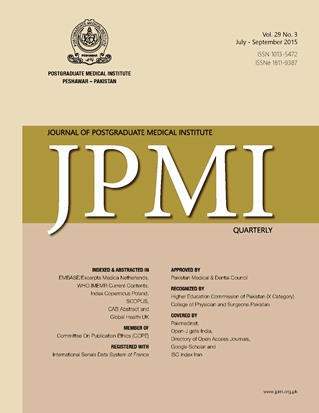IS THERE ANY IMPACT OF EMPLOYMENT STATUS ON PREMENSTRUAL SYMPTOMATOLOGY?
Main Article Content
Abstract
Objective: To find out the difference between various premenstrual symp -toms in employed and unemployed women.
Methodology: This was a cross sectional, prospective, comparative study con -ducted from May 2010 to April 2011, in Emergency and Out Patient sections
of Obstetrics and Gynecology department, Lady Reading Hospital, Peshawar.
By purposive non-probability sampling technique, 150 subjects were selected
among attendants of regular patients, after fulfilling inclusion criterion of em-ployed and unemployed women, in age group of 15-40years. Premenstrual
symptoms were recorded as, Quantification of severity of psychological, social
and physical symptoms, for two consecutive symptomatic cycles. SPSS 16.0
was used to analyze the data. Chi-Square test was used to compare the pre-menstrual symptoms between employed and unemployed women. P value ≤
0.05 was taken as significant between pairs of variables.
Results: A total of 150 female patients recruited in the study. Out of these
50.7% (n=76) were employed and unemployed were 49.3% (n=74). Mean age
was 26±6.2 years (15-45). Overall 72% (n=109) of subjects were symptomat-ic with one or more premenstrual symptoms. Psychological symptoms were
found in 68 of 150 women (45%). About 50% of women in the employed
group had psychological symptoms as compared to 40% in the un-employed
group. Social symptoms were present in 64 of 150 women (42%). About 36
out of 76 employed women (47%) whereas 28 out of 74 un-employed women
(37%) reported social symptoms. Physical symptoms were present in 89 of 150
women (59%). These were present in 43 out of 76 employed (56%) and 46 out
of 74 un-employed women (62%).
Conclusion: The results suggest that the distribution of premenstrual symp-toms does not vary significantly between employed and un-employed wom -en. Although different groups of females may have different manifestations,
these are not statistically significant to emphasize the role of environmental
factors in its causation.
Methodology: This was a cross sectional, prospective, comparative study con -ducted from May 2010 to April 2011, in Emergency and Out Patient sections
of Obstetrics and Gynecology department, Lady Reading Hospital, Peshawar.
By purposive non-probability sampling technique, 150 subjects were selected
among attendants of regular patients, after fulfilling inclusion criterion of em-ployed and unemployed women, in age group of 15-40years. Premenstrual
symptoms were recorded as, Quantification of severity of psychological, social
and physical symptoms, for two consecutive symptomatic cycles. SPSS 16.0
was used to analyze the data. Chi-Square test was used to compare the pre-menstrual symptoms between employed and unemployed women. P value ≤
0.05 was taken as significant between pairs of variables.
Results: A total of 150 female patients recruited in the study. Out of these
50.7% (n=76) were employed and unemployed were 49.3% (n=74). Mean age
was 26±6.2 years (15-45). Overall 72% (n=109) of subjects were symptomat-ic with one or more premenstrual symptoms. Psychological symptoms were
found in 68 of 150 women (45%). About 50% of women in the employed
group had psychological symptoms as compared to 40% in the un-employed
group. Social symptoms were present in 64 of 150 women (42%). About 36
out of 76 employed women (47%) whereas 28 out of 74 un-employed women
(37%) reported social symptoms. Physical symptoms were present in 89 of 150
women (59%). These were present in 43 out of 76 employed (56%) and 46 out
of 74 un-employed women (62%).
Conclusion: The results suggest that the distribution of premenstrual symp-toms does not vary significantly between employed and un-employed wom -en. Although different groups of females may have different manifestations,
these are not statistically significant to emphasize the role of environmental
factors in its causation.
Article Details
How to Cite
1.
Hayat N, Perveen S. IS THERE ANY IMPACT OF EMPLOYMENT STATUS ON PREMENSTRUAL SYMPTOMATOLOGY?. J Postgrad Med Inst [Internet]. 2015 Dec. 12 [cited 2026 Jan. 2];29(3). Available from: https://jpmi.org.pk/index.php/jpmi/article/view/1747
Issue
Section
Original Article
Work published in JPMI is licensed under a
Creative Commons Attribution-NonCommercial 2.0 Generic License.
Authors are permitted and encouraged to post their work online (e.g., in institutional repositories or on their website) prior to and during the submission process, as it can lead to productive exchanges, as well as earlier and greater citation of published work.


